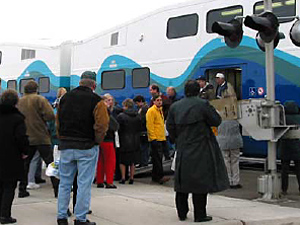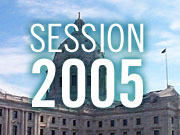January 24, 2005
 |
| The Northstar commuter line funding was the main flashpoint during Monday's debate. Sen. Mady Reiter, R-Shoreview, tried to strip the funding from the bill, saying the train wouldn't produce an adequate return on the investment. (File photo: northstartrain.org) |
St. Paul, Minn. — A public works bill was supposed to be the main order of business during last year's legislative session, but it fell victim -- like most initiatives -- to partisan squabbling and gridlock that paralyzed most of the agenda.
Keith Langseth, who chairs the Senate Capital Investment Committee, says that delay has thrown building projects into confusion and cost precious time. The Glyndon DFLer says it's imperative to have funding in place by the time the ground thaws for springtime construction.
"For those who might think we're moving a little fast, let's remember we're eight months late. So this year, it's very important that we go quite early, I think, and get the ball moving because we're already just about a year late," Langseth said.
The Senate plan covers the breadth of state government, offering millions of dollars to higher education systems to maintain or expand their facilities. It provides for natural resource protection, bioscience grants, the proposed Northstar commuter rail line between Minneapolis and Big Lake, and upgrades at the Minnesota Zoo. And it's financed, mostly, through the sale of almost $980 million in state bonds.
By contrast, Gov. Pawlenty's proposal is only three-quarters of that size, with most of the difference coming at the expense of the Minnesota State Colleges and Universities System.
Pawlenty spokesman Brian McClung says the governor is willing to discuss some middle ground.
"We are a little bit surprised at the size of this bonding bill, but the governor has said that as long as proponents can show how they would pay for it, then he's open to a bonding bill that's slightly larger than the one he proposed," McClung says.
The few dissenting voices in the Senate debate raised a similar concern. Because the state has yet to release its final budget forecast for the session, it's not clear how the state will repay the money it borrows to finance the bonding bill, and the debt service on the Senate plan is likely to add tens of millions of dollars to the state's budget pressures.
Sen. Warren Limmer, R-Maple Grove, argued against passing the package until all the funding pieces were laid out.
"The question of whether or not that debt service will come out of the expenses of education or health care or, at the very worst, we entertain the prospects of a tax increase to pay for this has yet to be answered," he said.
But Langseth says the Senate plan is still within an informal guideline that keeps debt repayments below three percent of the state's expenses. Even so, he acknowledged he'd probably need to trim his bill somewhat as he works out details with the governor and the House.
"I could come down some and keep a pretty good basic bill, but I can't come down a lot. And that's my concern. If they come in quite low, then we've got to start putting off some projects that I think should definitely be done this year," Langseth said.
House leaders have submitted a bill that is just about half of the Senate figures. But Dan Dorman, who is Langseth's House counterpart, says that number will quickly rise. The Albert Lea Republican says last year's House proposal was set artificially low as a negotiating tactic. This year, he expects the House bill to fall somewhere between what Pawlenty and the Senate have proposed.
"So it's a place holder; something that I think we wanted to send a signal that we're serious about a bonding bill, serious about it sooner rather than later, and had a lot of the consensus items in there. And what we add to it will be based on the actions of the committee and the floor," he said.
Dorman says he, too, feels the pressure to act quickly to salvage the upcoming construction season. He says he'll try to have the House bonding plan ready by the end of February and, after working out differences with the Senate, on the governor's desk in March.





